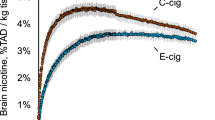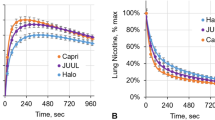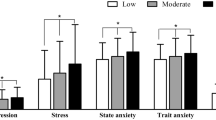Abstract
Menthol cigarettes are likely associated with greater risks of smoking dependence than non-menthol cigarettes. We sought to test the hypothesis that menthol increases the rate of brain nicotine accumulation (BNA) during smoking and thereby enhances its addictive effects. In a counter-balanced cross-over design, 10 menthol and 9 non-menthol smokers (10 females and 9 males; mean age 44.3) underwent two study phases. In each phase, the participant smoked exclusively either menthol or non-menthol research cigarettes for approximately 1 week prior to a positron emission tomography (PET) scan session, during which the subject’s head was scanned following inhalation of a single puff of smoke from a cigarette containing 11C-nicotine. No differences in initial slope, Cmax, area under curve (AUC), and T1/2 of BNA were found between menthol and non-menthol cigarettes across all subjects; however, menthol relative to non-menthol cigarettes were associated with steeper initial slopes in men (p=0.008). Unexpectedly, women had faster BNA as indicated by greater values of the initial slope, Cmax, AUC, and shorter T1/2 than men (all ps<0.04). The rates of BNA were significantly correlated with ratings of smoking motivations of getting a ‘rush’, getting relaxing effects and marginally with alleviation of craving. These results do not provide strong support for the putative role of menthol in enhancing BNA, although further studies should explore the apparent effect of menthol on BNA in men. Fast BNA during smoking and preference of sensory properties of menthol cigarettes may independently or jointly contribute to smoking dependence among women.
Similar content being viewed by others
Log in or create a free account to read this content
Gain free access to this article, as well as selected content from this journal and more on nature.com
or
References
Ahijevych K, Parsley LA (1999). Smoke constituent exposure and stage of change in black and white women cigarette smokers. Addict Behav 24: 115–120.
Ahmadi G (2009). Lagrangian versus Eulerian Method for Nano-Particles. Paper presented at the AVT-169 RTO AVT/VKI Lecture Series; 9–12 February 2009; von Karman Institute, Rhode St. Genèse, Belgium. http://www.cso.nato.int/pubs/rdp.asp?RDP=RTO-EN-AVT-169.
Baker TB, Brandon TH, Chassin L (2004). Motivational influences on cigarette smoking. Annu Rev Psychol 55: 463–491.
Behm FM, Rose JE (1994). Reducing craving for cigarettes while decreasing smoke intake using capasaicin-enhanced low-tar cigarettes. Exp Clin Pharmacol 2: 143–153.
Benowitz NL (1990). Clinical pharmacology of inhaled drugs of abuse: implications in understanding nicotine dependence. NIDA Res Monogr 99: 12–29.
Benowitz NL, Porchet H, Sheiner L, Jacob P 3rd (1988). Nicotine absorption and cardiovascular effects with smokeless tobacco use: comparison with cigarettes and nicotine gum. Clin Pharmacol Ther 44: 23–28.
Berridge MS, Apana SM, Nagano KK, Berridge CE, Leisure GP, Boswell MV (2010). Smoking produces rapid rise of [11C]nicotine in human brain. Psychopharmacology (Berl) 209: 383–394.
Brody AL, Mandelkern MA, London ED, Olmstead RE, Farahi J, Scheibal D et al (2006). Cigarette smoking saturates brain alpha 4 beta 2 nicotinic acetylcholine receptors. Arch Gen Psychiatry 63: 907–915.
Cepeda-Benito A, Reynoso JT, Erath S (2004). Meta-analysis of the efficacy of nicotine replacement therapy for smoking cessation: Differences between men and women. J Consult Clin Psychol 72: 712–722.
Charan NB, Thompson WH, Carvalho P (2007). Functional anatomy of bronchial veins. Pulm Pharmacol Ther 20: 100–103.
Clark PI, Gautam S, Gerson LW (1996). Effect of menthol cigarettes on biochemical markers of smoke exposure among Black and White smokers. Chest 110: 194–198.
Crapo RO, Morris AH, Gardner RM (1982). Reference values for pulmonary tissue volume, membrane diffusing capacity, and pulmonary capillary blood volume. Bull Eur Physiolopathol Respir 18: 893–899.
Dani JA, Bertrand D (2007). Nicotinic acetylcholine receptors and nicotinic cholinergic mechanisms of the central nervous system. Annu Rev Pharmacol Toxicol 47: 699–729.
Eccles R (1994). Menthol and related cooling compounds. J Pharm Pharmacol 46: 618–630.
Eissenberg T, Adams C, Riggins EC 3rd, Likness M (1999). Smokers' sex and the effects of tobacco cigarettes: subject-rated and physiological measures. Nicotine Tob Res 1: 317–324.
Foltin RW, Fischman MW (1991). Smoked and intravenous cocaine in humans: acute tolerance, cardiovascular and subjective effects. J Pharmacol Exp Ther 257: 247–261.
Food and Drug Administration (2013). Preliminary scientific evaluation of the possible public health effects of menthol versus nonmenthol cigarettes. http://www.fda.gov/downloads/scienceresearch/specialtopics/peerreviewofscientificinformationandassessments/ucm361598.pdf.
Gan WQ, Cohen SB, Man SF, Sin DD (2008). Sex-related differences in serum cotinine concentrations in daily cigarette smokers. Nicotine Tob Res 10: 1293–1300.
Giovino GA, Sidney S, Gfroerer JC, O’Malley PM, Allen JA, Richter PA et al (2004). Epidemiology of menthol cigarette use. Nicotine Tob Res 6: S67–S81.
Green BG (1992). The sensory effects of l-menthol on human skin. Somatosens Mot Res 9: 235–244.
Halldin C, Någren K, Swahn CG, Långström B, Nybäck H (1992). (S)- and (R) [11C]nicotine and the metabolite (R/S)-[11C]cotinine. Preparation, metabolite studies and in vivo distribution in the human brain using PET. Int J Rad Appl Instrum B 19: 871–880.
Heatherton TF, Kozlowski LT, Frecker RC, Fagerstrom KO (1991). The Fägerstrom Test for Nicotine Dependence: a revision of the Fagerstrom Tolerance Questionnaire. Br J Addict 86: 1119–1127.
Henningfield JE, Keegan RM (1993). Nicotine delivery kinetics and abuse liability. J Consult Clin Psychol 61: 743–750.
Ingebrethsen BJ (2006). Numerical simulation of the effects of dilution level, depth of inhalation, and smoke composition on nicotine vapor deposition during cigarette smoking. Inhal Toxicol 18: 1071–1076.
Jaques PA, Kim CS (2000). Measurement of total lung deposition of inhaled ultrafine particles in healthy men and women. Inhal Toxicol 12: 715–731.
Jarvik ME, Tashkin DP, Caskey NH, McCarthy WJ, Rosenblatt MR (1994). Mentholated cigarettes decrease puff volume of smoke and increase carbon monoxide absorption. Physiol Behav 56: 563–570.
Kobayashi D, Matsuzawa T, Sugibayashi K, Morimoto Y, Kimura M (1994). Analysis of the combined effect of l-menthol and ethanol as skin permeation enhancers based on a two-layer skin model. Pharm Res 11: 96–103.
Kunta JR, Goskonda VR, Brotherton HO, Khan MA, Reddy IK (1997). Effect of menthol and related terpenes on the percutaneous absorption of propranolol across excised hairless mouse skin. J Pharm Sci 86: 1369–1373.
Le Foll B, Wertheim C, Goldberg SR (2007). High reinforcing efficacy of nicotine in non-human primates. PLoS ONE 2: e230.
Lunell E, Bergström M, Antoni G, Långström B, Nordberg A (1996). Nicotine deposition and body distribution from a nicotine inhaler and a cigarette studied with positron emission tomography. Clin Pharmacol Ther 59: 593–594.
McCarthy WJ, Caskey NH, Jarvik ME, Gross TM, Rosenblatt MR, Carpenter C (1995). Menthol vs nonmenthol cigarettes: Effects on smoking behavior. Am J Public Health 85: 67–72.
Mead J (1980). Dysanapsis in normal lungs assessed by the relationship between maximal flow, static recoil, and vital capacity. Am Rev Respir Dis 121: 339–342.
Mellman I, Fuchs R, Helenius A (1986). Acidification of the endocytic and exocytic pathways. Annu Rev Biochem 55: 663–700.
Myers CS, Taylor RC, Moolchan ET, Heishman SJ (2008). Dose-related enhancement of mood and cognition in smokers administered nicotine nasal spray. Neuropsychopharmacology 33: 588–598.
O'Dell LE, Torres OV (2014). A mechanistic hypothesis of the factors that enhance vulnerability to nicotine use in females. Neuropharmacology 76: 566–580.
Perkins KA (2001). Smoking cessation in women. Special considerations. CNS Drugs 15: 391–411.
Perkins KA, Donny E, Caggiula AR (1999). Sex differences in nicotine effects and self-administration: review of human and animal evidence. Nicotine Tob Res 1: 301–315.
Perkins KA, Gerlach D, Vender J, Grobe J, Meeker J, Hutchison S (2001). Sex differences in the subjective and reinforcing effects of visual and olfactory cigarette smoke stimuli. Nicotine Tob Res 3: 141–150.
Perkins KA, Scott J (2008). Sex differences in long-term smoking cessation rates due to nicotine patch. Nicotine Tob Res 10: 1245–1251.
Rose JE, Mukhin AG, Lokitz SJ, Turkington TG, Herskovic J, Behm FM et al (2010). Kinetics of brain nicotine accumulation in dependent and nondependent smokers assessed with PET and cigarettes containing 11C-nicotine. PNAS 107: 5190–5195.
Scharf D, Shiffman S (2004). Are there gender differences in smoking cessation, with and without bupropion? Pooled- and meta-analyses of clinical trials of Bupropion SR. Addiction 99: 1462–1469.
Shojaei AH, Khan M, Lim G, Khosravan R (1999). Transbuccal permeation of a nucleoside analog, dideoxycytidine: Effects of menthol as a permeation enhancer. Int J Pharm 192: 139–146.
Sloan A, DeCort SC, Eccles R (1993). Prolongation of breathhold time following treatment with an L-menthol lozenge in healthy man. J Physiol 473: 53P.
Sofuoglu M, Mooney M (2009). Subjective responses to intravenous nicotine: greater sensitivity in women than in men. Exp Clin Psychopharmacol 17: 63–69.
Squier CA, Mantz MJ, Wertz PW (2010). Effects of menthol on the penetration of tobacco carcinogens and nicotine across porcine oral mucosa ex vivo. Nicotine Tob Res 12: 763–767.
US Department of Health and Human Services (1998) Tobacco use among U.S. racial/ethnic groups—African Americans, American Indian and Alaska Natives, Asian Americans and Pacific Islanders, and Hispanics: A report of the surgeon general. US Department of Health and Human Services, Centers for Disease Control and Prevention: Atlanta, GA.
Volkow ND, Wang GJ, Fowler JS, Logan J, Gatley SJ, Wong C et al (1999). Reinforcing effects of psychostimulants in humans are associated with increases in brain dopamine and occupancy of D2 receptors. J Pharmacol Exp Ther 291: 409–415.
Xu J, Azizian A, Monterosso J, Domier CP, Brody AL, Fong TW et al (2008). Gender effects on mood and cigarette craving during early abstinence and resumption of smoking. Nicotine Tob Res 10: 1653–1661.
Yamamoto RT, Rohan ML, Goletiani N, Olson D, Peltier M, Renshaw PF et al (2012). Nicotine related brain activity: the influence of smoking history and blood nicotine levels, an exploratory study. Drug Alcohol Depend 129: 137–144.
Yano R, Hayakawa D, Emura S, Chen H, Ozawa Y, Taguchi H et al (2002). Effects of cigarette smoke exposure on the ultrastructure of the golden hamster parathyroid gland. Histol Histopathol 17: 375–381.
Zeman MV, Hiraki L, Sellers EM (2002). Gender differences in tobacco smoking: higher relative exposure to smoke than nicotine in women. J Womens Health Gend Based Med 11: 147–153.
Acknowledgements
We thank Al Salley, Tanaia Loeback, Wendy Roberts, and David Botts for subject recruitment, and Dena Hill-Cairnes, Alana Cataldo, and Kelsey Behrens for assistance in data collection and processing.
Author information
Authors and Affiliations
Corresponding author
Additional information
Supplementary Information accompanies the paper on the Neuropsychopharmacology website
Rights and permissions
About this article
Cite this article
Zuo, Y., Mukhin, A., Garg, S. et al. Sex-Specific Effects of Cigarette Mentholation on Brain Nicotine Accumulation and Smoking Behavior. Neuropsychopharmacol 40, 884–892 (2015). https://doi.org/10.1038/npp.2014.263
Received:
Revised:
Accepted:
Published:
Issue date:
DOI: https://doi.org/10.1038/npp.2014.263
This article is cited by
-
Comparison of brain nicotine accumulation from traditional combustible cigarettes and electronic cigarettes with different formulations
Neuropsychopharmacology (2024)
-
Comparison of brain nicotine uptake from electronic cigarettes and combustible cigarettes
Neuropsychopharmacology (2022)
-
Sex differences in tobacco withdrawal and responses to smoking reduced-nicotine cigarettes in young smokers
Psychopharmacology (2018)
-
Sex Differences in Midbrain Dopamine D2-Type Receptor Availability and Association with Nicotine Dependence
Neuropsychopharmacology (2016)



